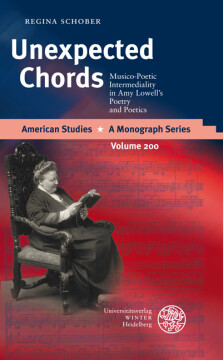
BUCH
Unexpected Chords
Musico-Poetic Intermediality in Amy Lowell´s Poetry and Poetics
American Studies – A Monograph Series, Bd. 200
2012
Zusätzliche Informationen
Bibliografische Daten
Abstract
One of the central figures of the Imagist movement, American poet Amy Lowell (1874–1925) experimented with poetic Language and form by turning to the musical medium. This book examines the various ways in which the concept of music relates to and shapes Lowell’s poetical and critical work. In Lowell’s poems, music functions not only as sonic and rhythmic material or structural model, but also as a theme, reflecting cultural and aesthetic debates of an emerging modernity, such as gender, effects of urbanization, the First World War, primitivism, and cultural validity. In her critical writings, the idea of music fosters Lowell’s development of free verse, polyphonic prose, and her performative poetics. In considering Lowell’s poetry and poetics through its ‘medial other’, this study aims at re-positioning Lowell within a Literary and Cultural Studies discourse which accounts for the intermedial nature of her Modernist aesthetics.
Inhaltsverzeichnis
| Zwischenüberschrift | Seite | Aktion | Preis |
|---|---|---|---|
| Acknowledgements | 5 | ||
| Contents | 7 | ||
| Introduction | 9 | ||
| 1 Musico-Poetic Intermediality | 53 | ||
| 1.1 Terminology, Theories, and State of Research | 56 | ||
| 1.2 Intermedial Approaches to Amy Lowell's Poetry | 61 | ||
| 1.2.1 Imagine Media! (Inter)Medial Conceptualization | 63 | ||
| 1.2.2 Music Into Text: Intermedial Translation | 69 | ||
| 1.2.3 Dissolving Media: Modal Intersections | 77 | ||
| 1.3 Intermedial Perspectives: Amy Lowell Revisited | 82 | ||
| 2 Music Abstracted: A Romantic Ideal of Music in "A Dome of Many-Coloured Glass" | 85 | ||
| 2.1 Harmony and the Ideal of Unity | 93 | ||
| 2.2 Beating Eternity: Time and Metaphysics | 97 | ||
| 2.3 Lowell's Songbirds: Nature as Creative Inspiration | 107 | ||
| 3 The Silence Almost is a Sound: Sonic Representation from Synesthesia to Noise | 117 | ||
| 3.1 Synestesia or Intersensoriality? | 123 | ||
| 3.2 How Still it is! The Absence of Sound | 132 | ||
| 3.3 The Restlessness of an Incongruous Century: Silencing the Noises of Modernity | 138 | ||
| 3.4 Nocturnal Silence | 150 | ||
| 4 The Music of Imagism | 159 | ||
| 4.1 Impressionism, Haiku, and the Superimposition of Images | 160 | ||
| 4.2 A Constant Modulation of Values: Free Verse and Musical Rhythm | 166 | ||
| 4.3 The Image of (Musical) Impressionism | 186 | ||
| 5 Polyphonic Prose and the Allegory of War | 191 | ||
| 5.1 Intrusion and Confusion: War Pictures | 208 | ||
| 5.2 The Complexities of Human Contact: Can Grande's Castle | 217 | ||
| 5.2.1 Identity and Synthesis | 221 | ||
| 5.2.2 Time and Space | 228 | ||
| 5.2.3 Chaos and Structure | 234 | ||
| 6 Translating Music, Translating Culture: Lowell's Grotesque (and) Primitivism | 241 | ||
| 6.1 Amy Lowell and the Grotesque | 245 | ||
| 6.2 From Eccentricity to Melancholy: Pierrot Lunaire turns Gothic | 252 | ||
| 6.3 After Hearing a Waltz by Bartók | 262 | ||
| 6.4 Amy Lowell's Peasant Dance: Translating Stravinsky's Primitivism | 280 | ||
| 6.5 Intermedial Translation as Cultural Translation | 294 | ||
| 7 Music as a Culturar Signifier | 297 | ||
| 7.1 The Value of Music: Negotiating Cultural Validity | 299 | ||
| 7.2 Music, Gender, and Sexual Desire | 318 | ||
| Conclusion | 331 | ||
| Bibliography | 337 | ||
| Archival Documents | 354 | ||
| Index | 357 | ||
| Example 1: Claude Debussy, “Poissons d’Or,” b. 1-6 | 172 | ||
| Example 2: Debussy, “Poissons d’Or,” b.30-1st beat of b. 31 | 174 | ||
| Example 3: Igor Stravinsky, Three Pieces no. 2, “Excentrique,” b. 13-14 | 255 | ||
| Example 4: Stravinsky, “Excentrique,” b. 31-33 | 256 | ||
| Example 5: Stravinsky, “Excentrique,” opening, b. 1-3 | 256 | ||
| Example 6: Stravinsky, “Excentrique,” b. 4-5 | 258 | ||
| Example 7: Béla Bartók, “Valse,” opening, b. 1-7 | 264 | ||
| Example 8: Bartók, “Valse,” b. 27-28 | 266 | ||
| Example 9: Bartók, “Valse,” b. 83-86 | 266 | ||
| Example 10: Bartók, “Valse,” b. 45-64 | 267 | ||
| Example 11: Bartók, “Valse,” b. 128-150 | 268 | ||
| Example 12: Bartók, “Valse,” b. 37-43 | 269 | ||
| Example 13: Stravinsky, Three Pieces no. 1, “Danse,” b. 1-10 | 287 | ||
| Example 14: Stravinsky, “Danse,” violin and cello opening motif, b .1 | 289 |


 Publishing Platform by CloudPublish
Publishing Platform by CloudPublish